NRJ is back: after 4 years of decreasing ratings, the Hit Music Only brand with the black panther has won 1 million listeners and once again became the top music station in France. Wanna’ know how?
In a Radiodays Europe 2013 session about the story of NRJ France as well as NRJ International, PD Davy ‘Morgan’ Serrano and NRJ consultant Peter Waak shared best practices for high radio ratings. Key insight? An essential part of radio programming is creative differentiation by taking positions, and defensive marketing by (re)claiming images.
“Master both the science and art
of great radio”
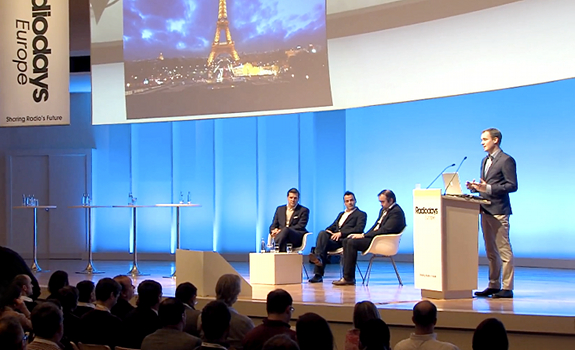
Radio Intelligence president Peter Waak (standing on the right) makes clear that the best program directors in the radio industry combine the best of both worlds – intellect and intuition (photo: ALEXberlinTV)
Develop your mission blueprint
‘The leading international brand for radio & music entertainment in the world’, it says in the NRJ brand reel that’s being played at the beginning of the presentation. Looking at the chart on the company’s website, they’re well on their way. From Russia to Tahiti – the Black Panther is leaving trails all over the map. “Every market we come to is unique, but what’s fascinating to see is that marketing principles for a great strategy are global”, according to Peter Waak, president of Radio Intelligence (a consultant to the NRJ Group). He’s introducing the session with 7 steps to develop a successful radio format:
1. Ideas: establish a fun and creative environment, engage your team to generate new ideas, and find inspiration from leading stations around the world
2. Analysis: identify the most attractive opportunities in the market by doing necessary research (such as mapping studies, music testing, and more)
3. Strategy: do the right things; develop a strategic plan that makes you different and credible in a relevant way, define a detailed target audience and completely understand their needs and expectations
4. Tactics: do things right; determine your tactics based on your strategy, in order to increase your relevance and deliver on your promise towards your station’s audience
5. Communication: define a unique position to stand out in a competitive media market, based on the key benefit for the audience, and tell it clearly and consistently
6. Engagement: have an innovative and strong digital & social media strategy; understand what content to provide when and on which platform(s) and how it all ties back to your main channel
7. Execution: set clear goals, develop an action plan with your team, execute it with passion as a team, and… have fun!
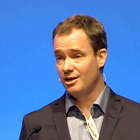 Combine ratio & gut feeling
Combine ratio & gut feeling
According to Waak, great radio program directors “master both the science and art of great radio”. Having worked with PDs in different radio markets all over the world, the president of Radio Intelligence has experienced that the best radio programmers in the business are the ones who “understand how to take all this knowledge and strategy, and make it into fantastic radio”. [Time management skills might come in hand as well?]
Install standard operating procedures
Morgan Serrano’s workday, for example, is rather busy. He combines being Managing Director for the NRJ Group with being PD of both NRJ France and NRJ International, thus overseeing their brand and format execution all over the world. In this double function he works with NRJ’s self-owned stations and franchise affiliates. [If you have multiple stations under the same umbrella, it might be helpful to bundle your best practices in an ‘operations manual’ that covers everything.] Going back to NRJ, the interesting thing is that it didn’t even take the company long to become a big player.
“Be everywhere with the listeners”
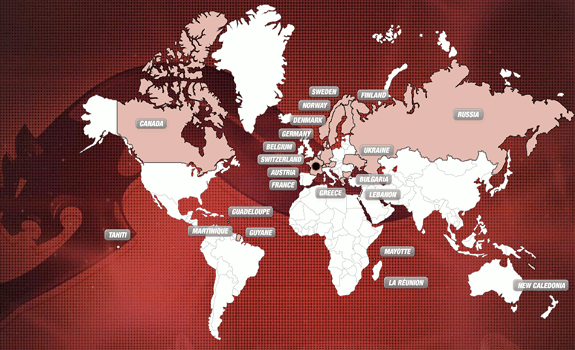
NRJ group program director Morgan Serrano sees their radio stations worldwide as multimedia brands that are present anywhere the audience is – from radio & TV to social media and events. This map shows where the Black Panther has left its footprints since he started his journey in Paris during the mid 1980s (original image: NRJ)
Put signal distribution first
The NRJ saga starts in 1981 in Paris, France, when Jean-Paul Baudecroux and Max Guazzini launch a free radio station called Nouvelle Radio des Jeunes or Nouvelle Radio Jeunesse (‘new radio for young people’). Its abbreviation sounds like ‘énergie’ – the French word for ‘energy’ – and is a cool name for a dynamic format of current hits. In just a few weeks, the new station becomes wildly popular. They have a powerful transmitter with a far reach, covering the entire market (city of Paris) as the antenna is installed on one of the highest points in the city. In addition, NRJ plays lots of music, has a modern sound, and is close to stars. But only after the French government allows radio advertising in 1984, things start to happen really, really fast.
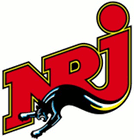 Duplicate your success format
Duplicate your success format
In 1986, NRJ is the first French radio to use satellite distribution, building a network of local frequencies. Two years later, they have 100 transmitters all across France and begin expanding into Switzerland and Belgium. Local teams use the radio group’s expertise and resources in terms of format, production, marketing, branding, and more. In ’89, the company is listed on the Paris Stock Exchange and continues to write history.
Meet your audience everywhere
“The main thing is really to be close to the listeners and to be everywhere with the listeners”, Serrano says in reference to NRJ as an international cross-media brand that operates on a wide scale:
- Radio: 500 transmitters in 15 countries, reaching 27 million listeners a week
- Webradio: 180 different web channels and 29 million listening sessions a month
- Television: TV brands include ‘enjoyment’ channel NRJ 12 (10 million viewers a day) and NRJ Hits
- Digital platforms: 15 music sites with 15 million visitors total, and 7 million app downloads so far
- Station events: NRJ Live Sessions, Music Tour, Music Awards, In the Park, Extravadance, etc.
- Social media: 4 million Facebook fans and 600.000 Twitter followers for NRJ France
(source: presentation and NRJ International Brand Reel, April 2012)
“If a songs exists on the web,
and we think it’s a hit, we play it”
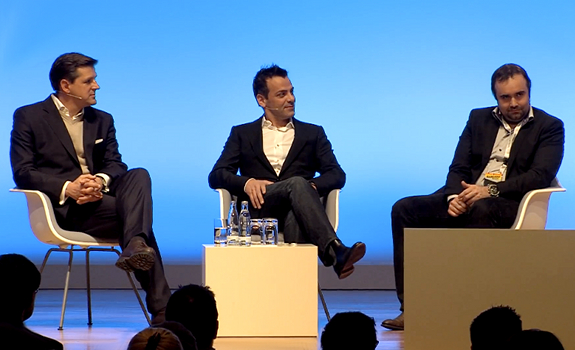
Morgan Serrano (sitting in between Olaf Hopp and station director Gaël Sanquer) explains that they keep a close eye on which songs are popular in online music platforms like iTunes and YouTube – indicating that the music industry has less and less influence on the playlist of major radio stations like NRJ France (photo: ALEXberlinTV)
Believe in CHR’s strength
Every story, even a success story, has its ups & downs. In 2010, flagship station NRJ France is facing a serious challenge: their ratings are decreasing – and not for the first time, it’s the fourth year in a row. In cume, the ‘Hit Music Only’ brand is then number 4 in the market and RTL (Full Service AC, or Généraliste, as the French name it) is number 1. “At this moment, 4 years ago, all over Europe a lot of people told me: the CHR format is finished now”, Morgan Serrano recalls. But that Contemporary Hit Radio has the potential to be the number 1 concept, is something he’s convinced of.
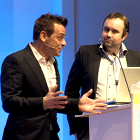 Build successful long-term partnerships
Build successful long-term partnerships
He and Gaël Sanquer, who together are a long-time radio couple, work at NRJ’s main competitor Fun Radio when Jean-Paul Baudecroux calls them to make an offer they can’t refuse. In 2 years time, Sanquer & Serrano get the ship back on course. Apart from a ratings growth of 1 million listeners to 6.2 million a day, NRJ also manages to become France’s #1 station in the early summer of 2012. [For current ratings, see Médiamétrie radio.]
Define your focus areas
Morgan Serrano mentions the 5 main principles that are the foundation of the successful comeback of NRJ in the French radio ratings. These are all based on a desire to become top of mind for the basic premise that whenever people think of ‘stars’ or ‘hits’, they think of ‘NRJ’:
1. Aggressive music positioning & strategy
First of all, market research was done – from mapping studies to define core music styles to continuous call-out hook testing to indentify listeners’ favorite songs. However, they added a relatively new component. The team decided to use online music platforms (like Shazam, YouTube, and iTunes) as guideline during their music meetings – rather than following the record company’s agenda. “If a songs exists on the web, and we think it’s a hit, we play it”, Serrano explains. An interesting fact is that even if NRJ is known for a ‘Hit Music Only’ position and even if they’re a mass-appeal format, they are not as defensive as many other program directors would be. They dare to take some risk and play more than only best-testing and well-familiar songs. “Really important is to be the first to play the new music; the future hits.”
“The most important thing is
to sell the music”

Even the NRJ morning show team (from left to right: Oriane, Manu, Stéphanie and Mourad) is embedded in a music-driven format, as there’s a reference to the station’s hit music position at least once every five minutes (photo: NRJ)
2. Powerful morning & evening shows
The NRJ morning show Manu Dans Le 6/9 Sur NRJ (Manu During 6/9 on NRJ) around radio personality Emmanuel Levy does include lots of fun, friendly and feel-good content and popular benchmarks like NRJ Double Votre Salaire Dans Le 6/9 (NRJ Doubles Your Salary During 6/9), every morning at 7:05 and 8:05. However, music is key – another area where NRJ is different from the average CHR in a given market. [I think that’s smart, because when you’re a music station while your AM show comes across as a talk show, you’re potentially damaging listener expectations that are based on your music image.] Morgan Serrano: “The most important thing is to sell the music during the breakfast show; sell the massive stars and talk about the music every five minutes.”
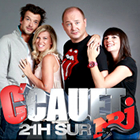 Young audience? Claim evenings!
Young audience? Claim evenings!
While many stations, besides mornings, focus on drive time, late evenings (9 PM to midnight) might be are more important for a station with a young audience as Serrano doesn’t mention drive time (nor the following slot until 9 PM) during his presentation at all. [Is that because young people are busier with friends, social media, Internet, television, and school assignments at the beginning of their evening?]
Open your studio doors
NRJ’s evening show is called C’Cauet Sur NRJ (It’s Cauet At NRJ). Presenter Sébastien Cauet is a French television star who always has been connected to radio, where his media career began. Morgan Serrano describes him as “a really funny guy” who is “really close to the listeners”. Literally, because NRJ decided to have a publicly accessible on-air studio where the host is actually surrounded by the audience, preferably from the show’s 13-24 year-old target audience demographic. Just like in the morning show, music and stars are a key ingredient. Therefore, Cauet sur NRJ features a lot of celebrity interviews. [Note how they always promote the broadcast time and/or station name in program titles – which I think is wise, because you’re less dependent on the name and status of an individual personality.]
“The main goal for us is
to be more fashionable than them”
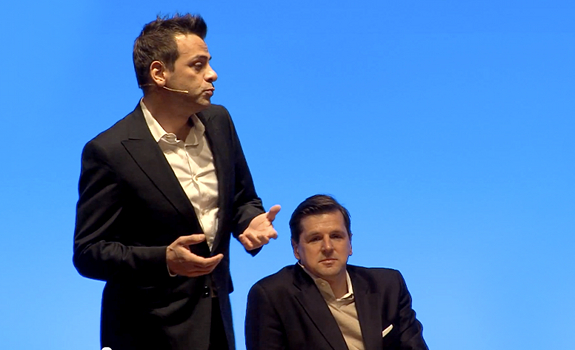
Station imaging on NRJ France serves two goals: letting them sound great, but also making competitors sound old-fashioned, NRJ program director Morgan Serrano (standing next to Olaf Hopp) explains (photo: ALEXberlinTV)
3. Heavy social network community
Serrano sees the impact of social media on the radio industry. In his opinion, today’s program directors are not only PD of the radio station, but also of social networks that are part of or connected to the main brand. Sébastien Cauet, for example, is also an asset for NRJ in terms of his 1.5 million Facebook fans and 600.000 Twitter followers. NRJ France is smart enough to also build a station-owned fanbase on social media platforms (Facebook: 2 million, Twitter: 1.3 million, as of April 2013). They’re also closely connected to the mobile generation; 2 million people are using NRJ’s smartphone services via apps for iPhone, Android, Windows 8 and Blackberry.
 4. Creative on-air sound & marketing
4. Creative on-air sound & marketing
Apart from imaging their own brand, they use sound design also to (re)position the competition – namely Fun Radio (Rhythmic CHR), Skyrock (Urban CHR), and the smaller Virgin Radio (Mainstream CHR). “The main goal for us is to be more fashionable than them; to try to make them dusty”, Morgan Serrano’s clarifies. The most commonly used radio imaging and branding elements on NRJ are jingles and power intros, as well as format explainers and station promos.
Use branded song intros
The program director describes the benefits of every main category of station imaging for the on-air sound of NRJ:
- Power intros sell the brand, music and stars all in one, without interrupting the flow
- Music demos explain the format in 20 seconds – they’re short, but played often during the day
- Global promos sell programs, especially the morning & evening shows, and listener interaction
- Jingle package fits with the music styles of the strategic study
[audio:http://www.radioiloveit.com/wp-content/uploads/morgan-serrano-nrj-radiodays-europe-2013-01.mp3|titles=Morgan Serrano about how NRJ is using station imaging]
(Power intros, jingles and musical logos are courtesy of PURE Jingles)
“Don’t be ‘very big’ and
far from the listeners”
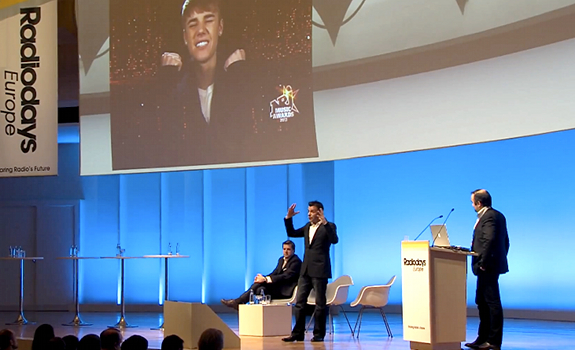
Program director Morgan Serrano knows that a friendly and personal tone of voice is a much better way of communicating with audiences, instead of coming across as very big, but distant (photo: ALEXberlinTV)
5. Strong off-air marketing & events
Apart from on-air promotion, off-air marketing and events play an important role in their brand strategy as well. NRJ Music Awards, every year in January in Cannes on the French Riviera, is one of the station’s major promotions. The event is televised on national channel TF1, attracting over 6 million viewers. Another one is NRJ In The Park, an open-air festival that, according to the organizers, is visited by over 100.000 people. Serrano shows a series of posters and billboards to illustrate that outdoor advertising still is a significant channel to protect your brand images by claiming them continuously – like NRJ does for the ‘hits’ and ‘stars’ positioning [great book]. “It’s really important to always have posters of massive stars, to keep them with us and never let them to the competitors.”
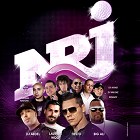 Program ‘marketable’ featured content
Program ‘marketable’ featured content
The PD reveals that they even create specialist shows to build marketing campaigns around them, in this case to own images for those music styles [probably to counter Fun Radio]. An example of this is NRJ’s Dance oriented programming on Friday & Saturday night, featuring Tiësto, Afrojack, Aviici and others: “It’s not a big part of our program, but we have a lot of marketing about it to ‘own’ the Dance music with the best deejays in the world.”
Communicate on personal level
Morgan Serrano underlines that they try to avoid any arrogance in marketing campaigns. They ask artists to speak directly to the listener in a conversational tone when they’re doing testimonials or making appearances in TV commercials for NRJ. “It’s the main important thing for us – not to be very big and far from the listeners, [but to be] always close to the listeners.”
[audio:http://www.radioiloveit.com/wp-content/uploads/morgan-serrano-nrj-radiodays-europe-2013-02.mp3|titles=Morgan Serrano about the essence of communicating with the audience]
Here’s the TV commercial for the NRJ Music Awards 2013, narrated by the legendary Richard Darbois:
http://www.youtube.com/watch?v=FYlpQAauADA





Hi,
Thank you for linking to the article!
Hope it has been helpful for you and your readers at Radioassistant.dk.
Best regards,
Thomas